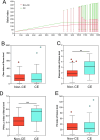Chronic endometritis and the endometrial microbiota: implications for reproductive success in patients with recurrent implantation failure
- PMID: 38816832
- PMCID: PMC11140900
- DOI: 10.1186/s12941-024-00710-6
Chronic endometritis and the endometrial microbiota: implications for reproductive success in patients with recurrent implantation failure
Abstract
Background: Chronic endometritis (CE) is associated with poor reproductive outcomes, yet the role of endometrial microbiota in patients with recurrent implantation failure (RIF) and CE remains unclear. This study aims to characterize endometrial microbiota in RIF patients with CE and assess its implications for reproductive outcomes.
Methods: In this prospective study, we enrolled RIF patients both with and without CE. Endometrial and cervical samples were collected for 16 S rRNA gene sequencing. Microbiota composition was compared between groups using diversity indices, phylum, and genus-level analysis. Canonical correlation analysis (CCA) and Spearman's correlation coefficients were used to assess relationships between CE, reproductive outcomes, and microbiota. Predictive functional profiling was performed to evaluate metabolic pathways associated with CE.
Results: Endometrial microbiota in CE patients exhibited greater diversity and evenness compared to non-CE patients. Principal coordinates analysis (PCoA) revealed distinct clustering between CE and non-CE groups. Linear discriminant analysis (LDA) identified Proteobacteria, Aminicenantales, and Chloroflexaceae as characteristic of CE, while Lactobacillus, Acinetobacter, Herbaspirillum, Ralstonia, Shewanela, and Micrococcaceae were associated with non-CE. CCA demonstrated associations between CE, adverse reproductive outcomes, and specific bacterial taxa. Microbial metabolic pathways significantly differed between CE and non-CE groups, with enrichment in pathways related to cofactors, vitamins, secondary metabolites, and the immune system in CE patients.
Conclusion: RIF patients with CE exhibit distinct endometrial microbiota compositions associated with adverse reproductive outcomes. The increased microbial diversity and altered metabolic pathways in CE suggest a potential correlation with reproductive outcomes, although further studies are necessary to elucidate the causal relationship between microbiota alterations and fertility. Modulating the endometrial microbiome may represent a novel therapeutic strategy to improve IVF outcomes in patients with CE.
Keywords: Chronic endometritis; Endometrial microbiota; Microbial diversity; Recurrent implantation failure; Reproductive outcomes.
© 2024. The Author(s).
Conflict of interest statement
The authors declare that they have no competing interests.
Figures







Similar articles
-
Interaction Between Chronic Endometritis Caused Endometrial Microbiota Disorder and Endometrial Immune Environment Change in Recurrent Implantation Failure.Front Immunol. 2021 Oct 4;12:748447. doi: 10.3389/fimmu.2021.748447. eCollection 2021. Front Immunol. 2021. PMID: 34671363 Free PMC article.
-
Endometrial microbiota in infertile women with and without chronic endometritis as diagnosed using a quantitative and reference range-based method.Fertil Steril. 2019 Oct;112(4):707-717.e1. doi: 10.1016/j.fertnstert.2019.05.015. Epub 2019 Jul 18. Fertil Steril. 2019. PMID: 31327470
-
Analysis of the microbiota composition in the genital tract of infertile patients with chronic endometritis or endometrial polyps.Front Cell Infect Microbiol. 2023 May 22;13:1125640. doi: 10.3389/fcimb.2023.1125640. eCollection 2023. Front Cell Infect Microbiol. 2023. PMID: 37284497 Free PMC article.
-
Chronic endometritis and recurrent reproductive failure: a systematic review and meta-analysis.Front Immunol. 2024 Aug 16;15:1427454. doi: 10.3389/fimmu.2024.1427454. eCollection 2024. Front Immunol. 2024. PMID: 39286255 Free PMC article.
-
Endometrial microbiota - do they mean more than we have expected?Ginekol Pol. 2020;91(1):45-48. doi: 10.5603/GP.2020.0010. Ginekol Pol. 2020. PMID: 32039468 Review.
Cited by
-
Vaginal Dysbiosis in Infertility: A Comparative Analysis Between Women with Primary and Secondary Infertility.Microorganisms. 2025 Jan 17;13(1):188. doi: 10.3390/microorganisms13010188. Microorganisms. 2025. PMID: 39858956 Free PMC article.
-
Uterine Microbiota and Bisphenols: Novel Influencers in Reproductive Health.J Xenobiot. 2025 Feb 2;15(1):26. doi: 10.3390/jox15010026. J Xenobiot. 2025. PMID: 39997369 Free PMC article. Review.
-
Correlation between uterine microbiota and pregnancy outcomes of embryo transfer in overweight and obese women.Front Cell Infect Microbiol. 2025 Feb 3;15:1515563. doi: 10.3389/fcimb.2025.1515563. eCollection 2025. Front Cell Infect Microbiol. 2025. PMID: 39963402 Free PMC article.
-
Causal association of the skin microbiome with human infertility: insights from a bidirectional two-sample Mendelian randomization.Arch Dermatol Res. 2025 Mar 17;317(1):565. doi: 10.1007/s00403-025-04098-x. Arch Dermatol Res. 2025. PMID: 40095168
-
The inconsistent pathogenesis of endometriosis and adenomyosis: insights from endometrial metabolome and microbiome.mSystems. 2025 May 20;10(5):e0020225. doi: 10.1128/msystems.00202-25. Epub 2025 Apr 22. mSystems. 2025. PMID: 40261026 Free PMC article.
References
-
- Moreno I, Cicinelli E, Garcia-Grau I, Gonzalez-Monfort M, Bau D, Vilella F, et al. The diagnosis of chronic endometritis in infertile asymptomatic women: a comparative study of histology, microbial cultures, hysteroscopy, and molecular microbiology. Am J Obstet Gynecol. 2018;218:e6021–16. doi: 10.1016/j.ajog.2018.02.012. - DOI - PubMed
MeSH terms
Substances
Grants and funding
- 82101710/National Natural Science Foundation of China
- 2022QNXM023/Science-Health Joint Medical Scientific Research Project of Chongqing
- cstc2021jcyj-msxmX0097/Natural Science Foundation of Chongqing Municipality
- FIRMD200502/Strategic Collaborative Research Program of the Ferring Institute of Reproductive Medicine, Ferring Pharmaceuticals and Chinese Academy of Sciences
LinkOut - more resources
Full Text Sources

